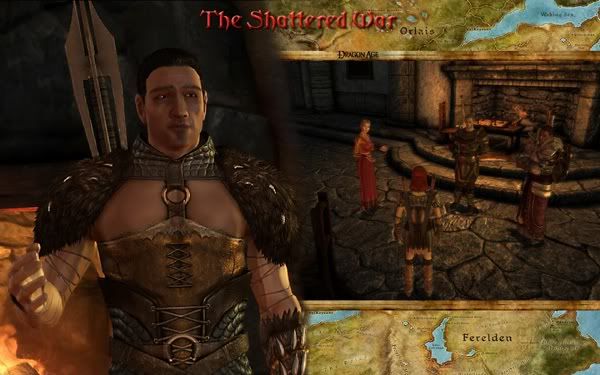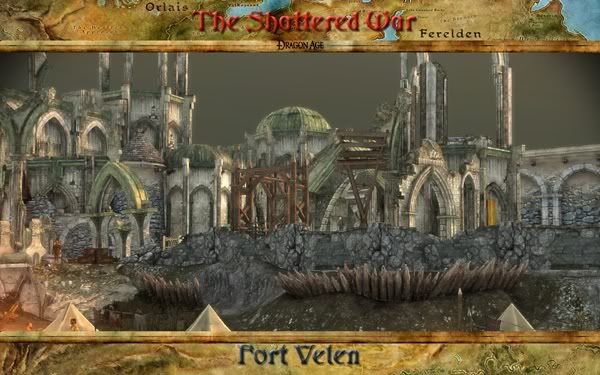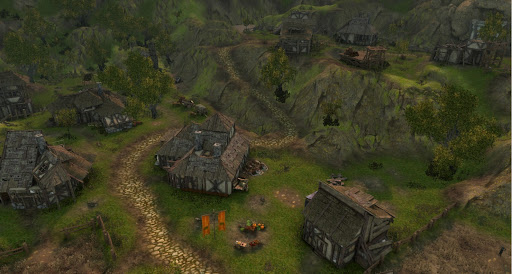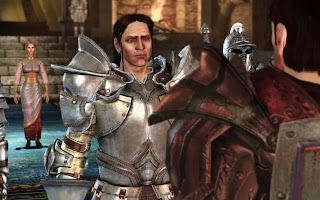Seriously, how many times did they have to say "Baldur's Gate" in that video? I vaguely remembering that they seemed to be harping on about it a lot when I first watched it (which was quite some time ago), but it really hit home for me watching it recently. Do RPG fans really still need to cling to a game released ten years ago as the be-all and end-all of what RPGs should be? I surely hope not. Yes, it does some things really well, but it's not the epitome of class in all areas. The game was great for its time, as was the entire series, but isn't it time people stopped letting one game define our entire concept of what RPGs should be like?
I'm going to focus primarily on BG2 in these posts, as it is generally regarded as the definitive chapter of the Baldur's Gate saga. There are points where I will touch on the series as a whole, but for the sake of brevity, I'll try to direct my focus. Now curiously, this is partially going to be a list of some of the things that BG2 does right, but I'm also going to address why those things don't really hold much sway, or shouldn't be copied for future RPGs. It's also a pretty long post as there is a lot to cover.
AD&D
Baldur's Gate was D&D (specifically 2nd Edition aka AD&D, and to some RPG players, AD&D is roleplaying. For me, that's a very narrow mindset. As someone who is mostly an outsider to D&D, the backlash against 3rd edition and 4th edition upon their release appeared significant. Many players seemed to be greatly attached to the mechanics of AD&D, and did not want to give them up for anything. Now, this may be anecdotal, but other mechanics are frequently viewed with skepticism, and players immediately want the combat mechanics to be broken apart for them so they can know their insides.A well-perused tome for many pen and paper RPG players
Forgotten Realms
The Forgotten Realms, or Faerun, is probably the most popular D&D setting. I don't have any statistics, but I'd hazard a guess that the number of campaigns, books and computer games set in Faerun is far more than any other setting by a significant amount. There are a massive number of established and popular characters within the setting, and the player gets to meet several of those figures within BG2. There's some definite fan service in their appearance, as there's no real reason for your character (even as a Bhaalspawn) to cross paths with so many famous people except simply to cater for fan desires to interact with them.Ideal level curve
BG2 puts the player across the ideal level curve for a grand adventure in D&D terms. Warriors don't start off as a fledgling weakling who can die to a single blow, and mages aren't ever stuck only being able to cast two spells a day. Even better, by the end of the game you're a powerful (but not unstoppable) character capable of overcoming some of the more potent dangers that exist within a classic fantasy world. Now, this is a well-picked scope for the game, but the reason it works is because of my next point...Bestiary
The game starts off with you fighting goblins, but this soon gives way to fighting more dangerous beasts. Golems, trolls, vampires, liches, demons, beholders and even dragons are put in your path before the game finishes, and you triumph over all of them. Now, the fights aren't necessarily easy, but they fit the aforemention level curve and showcase the improvement of your character. People love killing amazing enemies, and dragons are up there with the best things to put in a player's way. Players love killing a variety of different things, as it gives a sense of achievement, even if it's somewhat artificial. If you simply pitted the player against increasingly more difficult versions of the same looking enemies with more and more abilities, it doesn't feel as special to them. Players get an artificial sense of achievement through art style and diversity of enemies; the enemies could behave almost identically but look different and players will treat the enemy with a new level of respect. Yes, unfortunately we are that gullible, because players like to kill things that look cooler and more deadly. Don't believe me? Then why do people keep levelling up their characters to reach maximum level in WoW? Why is it exciting to go to a new in Azeroth and kill new enemies that have exactly the same simplistic AI as the ones you've been killing up until now?
Yay! It's dragon-killing time!
Drow
Drow seem to be like crack for many D&D fans. Heck, fantasy fans in general. Dark elves, or fallen elves or their equivalent are extremely common in many settings, for some reason that I simply don't get. Letting the player visit the Underdark, one massive underground dungeon home to Drow and countless other classic enemies, will automatically score points with fans. It's cool, but it's fan service.Even Bethesda loves "Dark Elves"
Now, many of these are reasonable for a game to include, but the problem is that they're not entirely transferable to other RPGs in general, especially ones set in a new intellectual property. The effect of the ideal level curve is transferable, because that can be implemented by different level mechanics outside of D&D. Implementing a good level curve is great for RPGs that involve levelling, because making the player feel more powerful as they progress without ever making them feel too weak or powerful is generally a good thing.
A large bestiary is the other widely applicable characteristic, more monsters will typically translate to "more fun" for the players. Of course, it is more work to create creatures than back in the 2D isometric days of BG2, as gamers now expect detailed and complete 3d models complete with "realistic" animations befitting their size, anatomy and actions. It's harder, but players will get a kick out of fighting different enemies as they go through the game.
So, let's consider some of the other elements of the game, like its character and gameplay...
The Protagonist
The player is "special", adhering to the classic "chosen one" trope that has plagued fantasy stories for years. Admittedly it is a little better presented in BG2's case than many others, but it's still there and very clear. Turning a cliche into an acceptable cliche is an achievement, certainly, but not one that games should try to replicate. Besides, does it feel more empowering for a player to be a chosen one who realises their destiny, or to be an ordinary person who rises to greatness of their own skill and talent?Romances
BG2 pretty much established in-game RPG romance with its three female leads: Jaheira, Viconia and Aerie. This basically set the standard for RPGs since that time, and players now expect to be able to have a romance with one or more NPCs in their games. Regardless, BG2 gave RPG players their first virtual romance experience, and many seem to still cling to this fondly. It's almost a little bit disturbing that some seem to treat it like a real-life romance, falling into the same trap of comparing each new romantic interest with their first. On that note, Baldur's Gate pretty much re-established the RPG genre when it was released, so there's probably no small amount of "this was my first real RPG" nostalgia associated with the game as well.Jaheira and Jaheira 2.0
Choice
I'm a big fan of choice in games, and in RPGs in particular, but in BG2 most of what we get is "choice-lite" or "character-defining choice". There are few decisions that actually effect the lore of the gameworld itself, despite the game being extremely high-powered towards the end - most of the effects the player has on the game world are pre-determined. Modern RPGs really outshine BG2 in this regard, actually giving consequences as a result of the player's choices.Combat
BG2's combat really doesn't have all that much depth, especially when it comes to the warrior classes, who basically just get pointed in the direction of an enemy and swing away without the player's input. As mages level up, they have the ability to gain a moderate repetoire of spells, but unless you're playing a sorceror, you have to pre-plan every encounter or select a very diverse range of spells because you have to memorise them ahead of time. You can't simply start a combat and pick the appropriate spell for the encounter, meaning that it's possible for your mage to either end the fight in a matter of seconds or have virtually no impact. Admittedly this is an inherent weakness of AD&D, but it's far less enjoyable than DAO's system where you can choose any spell out of those you know to adapt to the situation, and every class has abilities that you can choose to use at specific moments - you're rarely forced to be passive like you might have to be in a BG2 fight.BG2 Dragon sucker punch
Now, in all of this, I'm not taking anything away from BG2. It's still a well-crafted game and should be played by everyone who considers themselves a fan of RPGs. However, it's important to understand that some of the things that made it great were fan-service, and cannot or should not be repeated across other RPGs. There are elements of its design than have been surpassed by modern titles, and it's essential to realise the strengths and weakness of both old and new games in order to make games better.




































